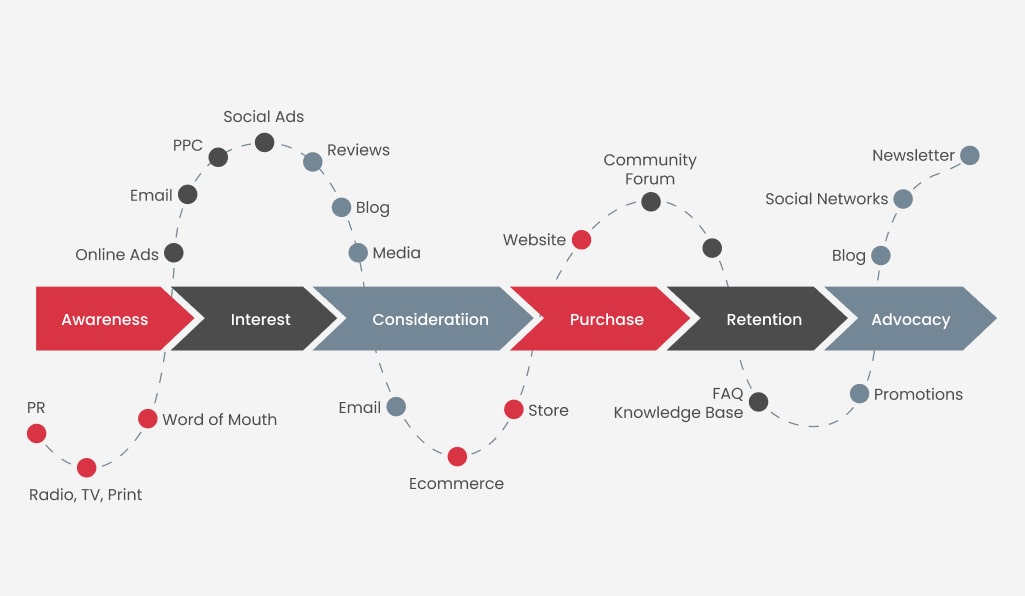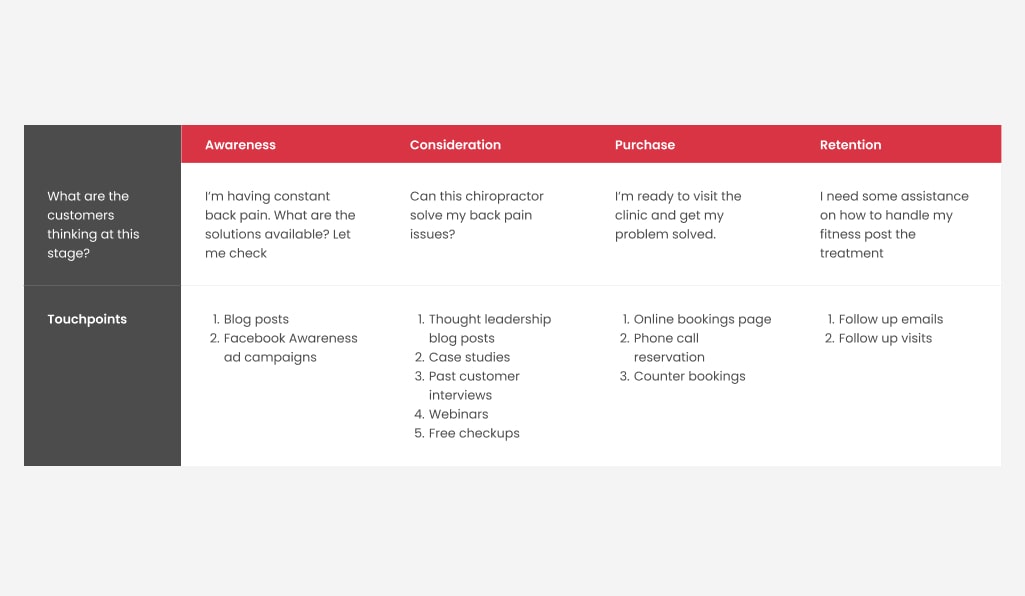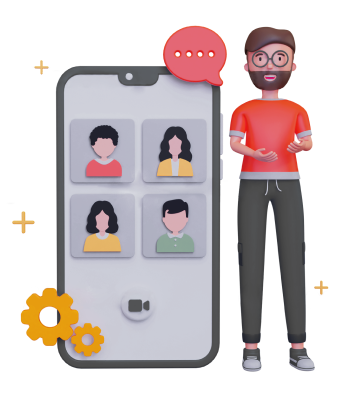- Blog
The Importance Of Knowing Your Customer Journey
Did you know that according to a Salesforce global research report, 80% of customers value the experience with a company just as much as the product?
What this means is even if your customers truly like the product, they may not stick around for long if the experience isn’t up to the mark. This would translate into lower sales, a high attrition rate, and unsatisfied customers. A well‐thought‐out customer journey map can help you solve this problem.
Mapping the customer journey is precisely how you can experience your business from a customer’s perspective rather than your own.
But that’s not all. There are several other ways a customer journey map can benefit your business. Here are the top six benefits of knowing the journey of a customer as they interact with your business:
Gain your customer’s perspective
Identify the pain points and increase conversion rate
Deliver a personalised user experience
Predict user behaviour and ROI
Create better content and identify content gaps
Build a company‐wide customer‐centric culture
In the subsequent sections, we deep dive into each of the benefits. Along with that, we discuss some crucial concepts like the different stages of a customer journey and show you real‐life examples. So read on till the very end!
What is the Customer Journey and What Does it Looks Like?
Before you learn about the benefits of a customer journey, here’s a quick refresher of what a customer journey is.
Simply put, a customer journey is the visual representation of the touchpoints a user takes on their way to purchase and beyond. Every interaction the user has with your brand is a touchpoint. If the route they follow only concerns digital touchpoints, then it is referred to as a ‘digital customer journey.’

Not all customer journey maps look the same. Some organisations present it as a linear map, while others create a slither-like map. But, again, the essence is the same. To understand a customer journey, you must learn about the various stages a customer goes through.
The Five Stages of the Customer Journey
The journey a user takes on their way to becoming a customer can be divided into five stages. Each of the stages marks a specific relationship between a business and a customer and they experience your business differently.
The five stages of a customer journey are:
The Awareness Stage
Awareness is the first stage of a customer journey. In this phase, the user becomes aware of the brand, product, or service. And they also realise that it can potentially solve the problem they’re faced with. In this digitally connected world, awareness can come from anywhere. This includes digital fronts like search engines, social media, forums, or traditional sources like word of mouth
The Consideration Stage
The second stage is the Consideration stage. After becoming aware of the product and how it can solve their problems, users mull over buying the product. They look at the features, pros and cons, read reviews, compare with alternatives, and consult their network.
Some users may also sign up for free trials or a product demo. This signals that they’re really interested in the product and are a few steps away from buying.
The Purchase Stage
The third stage is what most business owners are concerned with: the purchase stage or the conversion stage. At this stage, the customer has decided to buy your products. So they will place an order, either online or at the physical store, and officially become a customer.
Some customer journey maps end at the purchase stage. But there are two more stages you should know about.
The Retention Stage
The retention stage is the fourth stage of the customer journey. This stage is all about retaining a customer that has placed an order. Thus, it includes how the order is fulfilled, the shipping experience, after-sales support, product manuals, etc. This stage is also known as the experience stage.
Companies with poor retention strategies often experience higher churn rates. Customers who have bought something demand a refund or don’t buy it again.
The Loyalty Stage
The last stage of a customer journey is the loyalty stage. This is where buyers become advocates and start spreading the word about your brand. Successful businesses often have loyalty programs and personalised discounts at this stage to encourage buyers to spread the word.
6 Important Reasons to Know the Customer Journey
Traditionally, customer journey mapping was limited to the banking and insurance sector. They had a lengthier awareness‐to‐acquisition cycle. Hence, they needed a way to visualise this journey.
But with the advent of internet technologies, this cycle has widened for nearly every industry. It now takes 7 to 13 touches before you land a qualified lead. Thus, creating a customer journey is now more important than ever for businesses of any size.
Here are six reasons that’d convince you to invest in customer journey mapping:
Gain Your Customer’s Perspective
All businesses start with the aim of delivering value to customers. But it’s not uncommon for teams to stray from that aim and turn the focus on internal affairs. This is called the inside-out strategy, which is the root cause of issues like stagnation, revenue drop, and lack of innovation.
To break free, you must adopt an ‘outside-in approach.‘ And that’s when you’d need a customer journey map.
The outside-in approach forces you to put the customer at the centre. For this, you need a way to visualise how they interact with your business. You need to look at your business from the customer’s perspective. Once you understand their viewpoint, you can develop strategies to capture their interest and deliver on their desires.
The customer journey map essentially puts you in your customer’s shoes. And this can be a game changer for a business experiencing stagnation.
Identify the pain points and increase the conversion rate
Stats from Baymard Institute reveal that nearly 70% of the users who add products to their cart do not complete the purchase. The percentage is even higher for mobile users, with 85% of them abandoning their carts.
While there are several reasons at play, not identifying the exact pain points is one of them.
With a customer journey map, you can ensure you’re sending the relevant users to the product page. Directing a user who is on an awareness stage to a sales page may do more harm than good. You can also inspect the potential obstacles that are preventing them from completing the purchase.
Marketing teams can increase customer conversion rates by identifying and removing the pain points at each stage.
Deliver Personalised User Experience
The digital age has put power in the hands of the consumer. It has elevated their expectations for relevant and contextual experience that caters to their needs. And now the duty is on brands to deliver on those expectations.
But how can you create personalisation for all of your customers who are at different stages? With the help of a customer journey map. It will help you segment users based on which stage they’re at.
For example, all new visitors to the website are probably at the awareness stage. Likewise, most returning visitors are likely in the consideration phase since they’ve visited the website before.
Based on this information, you can customise the UX of the website to create a personalised experience.
You can do the same for users in the deeper sections of the customer journey. A study from Accenture noted that 91% of customers are likely to buy again if the company remembers their preferences.
Predict User Behavior and ROI
Big businesses spend billions of dollars on understanding and predicting user behaviour. Amazon is one of the best companies that has mastered the art of prediction and forecasting. By predicting user behaviour, they can influence it, thereby making more revenue per customer.
You can replicate the same for your business by segmenting users based on their current stages.
With sufficient data, the marketing team can identify the most valuable customers even at the awareness stage. Thus, you can divert more resources and focus on those customers. Conversely, without a map, you’d be missing out on touchpoints that produce the highest results.
Segmenting users based on a customer journey map also enables you to forecast ROI with more accuracy. You can forecast how many users are in the consideration phase and when they will place their orders. This information helps management make budgeting decisions.
Create Better Content and Identify Content Gaps
If you’re investing in content marketing, contemplate adding a well-articulated customer journey map to your strategy. This will offer clarity on the type of content you should produce for a particular type of user.
For example, users in the awareness phase would appreciate informative pieces to make a decision. Users in the consideration phase would prefer side-by-side comparison charts. Those in the loyalty phase would have different content requirements.
With a customer journey map, you can create personalised content for each segment.
Furthermore, you’d be able to identify gaps within the existing content library. If you find there are more users in the awareness phase and you can create sub-segments, it makes sense to personalise content a step further. Likewise, if there’s a FAQ page lacking for users in the retention stage, you can prioritize adding that page to move them to the loyalty stage.
Build a Company‐Wide Customer‐Centric Culture
When an organisation grows in size, teams often work in silos. They prioritise tasks differently, which leads to fragmentation within the company. The focus on customer value creation starts to drift.
A customer journey map is a great tool to help bring that focus back.
With the map in place, different teams can see the role they’re playing in improving the customer experience. The sales team will be responsible for onboarding the customer. But it’s the customer support’s job to get them through to the retention and loyalty stage.
This customer-centric unified approach encourages data sharing and collaboration. It may also improve productivity and employee satisfaction. Thus, it is a win-win for all the stakeholders, not only the customer.
The importance of the customer journey goes beyond the reasons mentioned above. Moreover, it can be used in any organisation in any sector, of any size.
Real-Life Example of a Customer Journey
To better articulate the customer journey, let’s take a real-world scenario of a patient who is suffering from lower back pain. He wants to get his back treated and end his suffering. The following figure describes the journey the patient goes through while interacting with a chiropractor clinic in his area:

- In the first stage, the patient is looking for solutions to his problems (the prolonged back pain). He comes across a chiropractor clinic through a Google search and reading one of their blog posts. And later he also saw an ad by the clinic on his Facebook feed. Now he is aware of the chiropractor clinic in his locality.
- In the consideration stage, the patient is not entirely sure whether the chiropractor can assuredly solve his problem. Thus, he reads a couple of thought leadership blog posts published by the chiropractor on back pain issues and goes through a few case studies. He may also watch past customer interviews uploaded on YouTube and attend free checkups if it’s on offer.
- In the third stage, the patient is done with his research and ready to undergo the treatment. So he either submits an online form or calls in to book a session. He is now a customer of the chiropractor clinic.
- In the retention stage, the patient will need assistance with aftercare. So he may visit the clinic again or seek help via phone calls, or emails.
Depending on how his experience has been from the moment he read the blog post to the follow-up visits, he will either become a loyal customer or a one‐off customer.
Loyal patients will make further visitations and recommend the clinic to their social circles.
Solve your problems with a well-thought Customer
